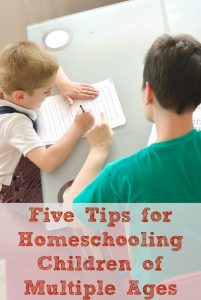Five Tips for Homeschooling Children of Multiple Ages
One of the greatest things about homeschooling for our family has been that all of our children of various ages have been able to spend time together day in and day out. It’s so much fun to have the opportunity to have all of the children together for fun days out on a field trip or a picnic, for playing together at break times during the day, for fun projects like putting on a play or making a funny video. But it’s also difficult at times to homeschool when you’re a family with kids of varied ages. Over the years I’ve learned some things that help homeschooling multiple kids of all ages go more smoothly.

Use unit studies.
I have found that unit studies work wonderfully for including children of all different ages in the same lessons. When I want to teach a subject or topic to multiple children at once, I’ve turned to unit studies many times. With a unit study, I can cover the material but adapt it to the ability of each different child. This works well because I’m preparing one main lesson and set of materials, but each child is able to learn at his or her own level.
When my children were middle school and younger, unit studies were my favorite way to teach. We’ve enjoyed many studies together with the older children completing assignments that were a little more difficult while the younger ones learned the same material but used it in an easier way. It’s amazing how much the younger children can learn from the older when we do this, and sometimes I’m surprised when the younger children will actually have a better grasp of the material than I expected. We’ve made many happy memories with unit studies that we completed all together as a family.
Combine kids of close ages when possible.
Our family works out to two “sets” of children by age. My oldest two are seventeen months apart; then we have a three year gap; and the youngest two are sixteen months apart. Although all families don’t work out so evenly, it’s often possible to combine sets of children that are close in age. I’ve often planned curriculum so that the older two work together and the younger two work together.
We don’t use grade leveled materials in our homeschool, so it’s been pretty easy to combine children for subjects like math and language arts when a unit study that includes all of the kids won’t necessarily work. This works out well because often kids learn from each other a skill or concept that they are struggling to learn from me. It also works out well when purchasing curriculum and planning lessons because I can narrow things down to two groups instead of four separate children.
Teach children to work independently.
From very early on, my goal has been to help my children develop into independent learners. The goal of school- I think- is to produce people who can learn. I can’t possibly teach my children every single skill, concept, fact, or idea in the world. No one can. But I can teach them how to learn those ideas for themselves. And learning to be an independent learner is so important.
Another benefit of raising independent learners is that very early on, I’ve taught the children to keep working independently on a task while I go and help someone else learn. From the time they were very young, I’ve expected them to be as independent as possible so that I can move back and forth among the kids and their schoolwork. The children know that they are expected to keep working and accomplish what they can independently while I go and work with someone else.
This teaching has paid off. My two high school students are now almost totally independent. I facilitate their learning by providing the materials and by helping with skills and answering questions- or helping them look up answers- when needed. I also follow up and check on all of their work. But they are independent, and they know how to learn for themselves. It’s great for them, and practically speaking, it frees me up to now work more with the younger children.
Divide school work into work that’s done together and work that is done independently.
Another important thing that has always helped with having multiple children of different ages is to divide up work into work that we can do together and work that is done independently. As I’ve said, my high school students are now almost totally independent. But when students are elementary and middle school aged, I’ve divided our school time into “together work” and “independent work.”
Together work involves subjects that I am going to teach. Often- because we use a literature-based curriculum- this means books I’m reading aloud that we are discussing or using in some way, such as a lapbook or literature unit. Independent work involves reading, workbooks, and computer-based instruction that each child does independently. Over time as the children get older, the balance shifts between the two. While they are very young, we are doing primarily together work, but by the time they’re finishing middle school, they are doing primarily independent work, as I’ve turned over subjects to them little by little.
Start the day together.
I love that we can start the day with all of the kids of all ages together. This is something I’ve tried to make a priority. We do devotions together at the start of our day. If I wait, everyone gets involved in his or her own work or in work we’re doing in smaller groups, and it’s difficult to get us all together again.
Starting our day together seems to give us a good focus for the day. It’s also a good time that we’re just all spending time together and focusing before we start for the day. The blessing of having all of my children of all ages all together for this time at the start of the day is one of the things I love best about homeschooling.

Yes, homeschooling multiple children in a variety of ages and stages can be challenging. But it can also be a blessing and a fun part of homeschooling. Try some of these tips to help your days go a little more smoothly and help your family to enjoy these homeschooling days together.
Leah Courtney is a homeschooling mom of four. Her days are filled with being a mom, homemaker, and teacher. In her (very rare) free time, she enjoys blogging, reading, and reviewing books and curricula. These days she’s learning the joys of being a mom of teens. You can read about her family and homeschooling life at As We Walk Along the Road.












































I enjoyed this article as we have had mixed ages of children, 9 to be exact. :0).
One thing we have done is also with toddlers, we got a tub of things just to use ONLY during our school time together, and put sidewalk chalk in it that they can use in a dry bathtub and be washed out, or store up our shampoo, dish soap, conditioner, Mayo jars, etc. and they have to match what lids go with what containers, stackable wooden blocks, and so forth, that we only brought out at that specific time. They couldn’t wait to see their “special toys’ each day to play with.
We also would have the older ones work for short periods teaching the younger ones with colors, numbers, ,addresses, phone numbers, and their names. This worked very well for us as the older ones took their ” jobs” seriously, and it was counted as part of their own schoolwork as well.
Just a few added ideas! Great article!
God bless,
Kelly Benedict